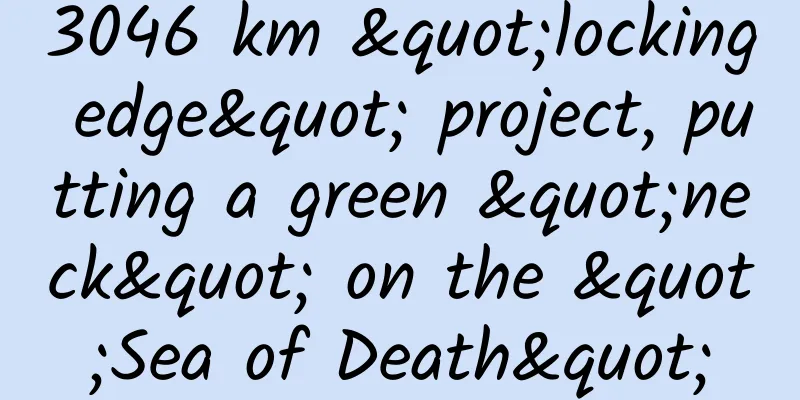How did China's proud "yellow soil" come into being?

|
China has a long history and splendid civilization. On this ancient land, there is a special piece of land - the Yellow Earth. This land has witnessed the evolution of the Chinese nation from primitive society to the feudal dynasty and has become a microcosm of Chinese civilization. It provides us with valuable information for interpreting Chinese civilization and allows us to deeply feel the historical heritage of Chinese civilization. China is the country with the widest distribution of loess in the world. The most concentrated and typical loess is found in the Loess Plateau in the northwest. Loess is a kind of soil rich in iron and aluminum, and is yellow-brown in color. The loess on the Loess Plateau has the characteristics of being cultivated, self-fertilizing, and having a deep soil layer, making it the most fertile soil in ancient China. Over thousands of years, the loess has gradually formed a loess layer several hundred meters thick in the long-term natural development process, becoming a unique landform in northern China. So, how did this thick loess form? The views that experts and scholars today agree on mainly include the "wind-formed theory", the "water-formed theory", and the "weathering residual theory". The aeolian theory of loess formation was first proposed by F.von Richthofen of Germany. Richthofen came to China in the mid-19th century and conducted field investigations and studies on the vast loess terrain in northwest China. Through observation and analysis of loess strata, he noticed that loess showed a layered structure, each layer consisting of fine particles, which was different from the stratigraphic structure formed by hydrogeology. At the same time, he also noticed that the loess region was very windy, especially in the dry season, when strong winds blew all year round. Based on these on-site findings, Richthofen proposed the aeolian theory of Chinese loess in 1877. He believed that northwest China was dry and rainy, but the average annual wind speed was high, especially in winter and spring every year, when strong winds blew frequently. These strong winds blew up the loose clay particles on the surface, transported and accumulated them in the air, and formed the loess layers we see over time. Richthofen's aeolian theory explained the formation mechanism of loess from the perspectives of morphology and geological environment, breaking through the mainstream view of the hydrogeological theory at the time. His theory provided a new perspective for the study of loess geology and explained the geological conditions for the formation of loess to a certain extent. Although subsequent studies also found that there were also water components in the formation of loess, Richthofen was the first to propose and explain the importance of wind as the dominant cause, which was of pioneering significance in the history of loess research. Typical loess aeolian area map (picture source: Internet) The "water-generated loess theory" advocates that the formation of loess is the result of long-term water erosion. In the past, the climate in northern China was relatively humid, and the rivers had large water volumes and fast flow rates. During their long-term flow, these rivers continuously washed down rock materials from the surface of the mountains. Among the washed down materials, clay and iron materials accounted for a high proportion and were difficult to be carried away by the water flow. As time went by, these materials gradually accumulated under the cliffs on both sides of the river and on the plains, eventually forming a loess layer. The formation of this theory is based on the study of the composition and distribution of loess. The main components of loess are clay and iron oxide, which is consistent with the composition of materials under river erosion. At the same time, the area where loess is distributed also highly overlaps with the area where ancient rivers were distributed. Through the study of the internal structure of loess, it was also found that there is an obvious horizontal stratification structure inside the loess layer, which also supports the view that loess was formed by water flow deposition. The weathering residual theory of loess believes that loess is formed by the weathering residues of basic rocks under dry climate conditions. However, weathering can only play a certain role in the formation of loess, and the soil depth it can affect is relatively shallow, which is difficult to apply to various situations in loess layers tens to hundreds of meters thick. Schematic diagram of the formation of the Loess Plateau (picture source: Internet) The Loess Plateau is one of the birthplaces of Chinese culture. Legend has it that the Yellow Emperor in ancient times was active in the Loess Plateau in northern Shaanxi. Later, the Yellow Emperor annexed the Yan Emperor tribe, defeated Chi You, unified the Central Plains, and became the ancestor of the Chinese nation. This shows that the Loess Plateau in northern Shaanxi was a livable place where humans originated from in ancient times. Today, the landforms of the Loess Plateau are broken, gullies are increasing, deserts are expanding, and rivers are silted up, which is in sharp contrast to the beautiful scenery of mountains and rivers in ancient times. The imbalance of the ecological environment of the Loess Plateau threatens the sustainable use of important national resources. How to promote the sustainable development of the regional economy while restoring the ecological environment of the Loess Plateau has become an important issue in the Loess Plateau. Soil erosion (Photo from the Internet) 1. Natural factors of soil erosion on the Loess Plateau 1. Climate factors Although the Loess Plateau belongs to the monsoon climate zone, it is far from the ocean and has a certain degree of continental climate. The degree of continentality gradually increases from southeast to northwest. The southeast has a semi-humid climate, the central part has a semi-arid climate type, and the northwest has an arid climate type. The main feature of atmospheric circulation is that the ground low-pressure system located in the westerly belt is frequent, resulting in heavy rain. Summer and autumn rainfall mostly occurs in the form of heavy rain, with heavy rainfall and rainfall intensity. This climate feature of frequent and strong rainstorms is very likely to cause soil erosion. 2. Soil factors Loess is a typical silt sediment, the main component of which is silt, especially coarse silt, followed by a certain amount of very fine sand and clay, which makes the loess very poor in anti-scouring properties. Although the porosity of loess is relatively large, the voids are very small, and most or even the vast majority are capillary voids, which are easily blocked by raindrops, making it very unfavorable for the water permeability and infiltration of loess, and easily causing over-seepage and runoff, leading to soil erosion. 3. Impact of neotectonic movement The Loess Plateau can be roughly divided into three parts: Longxi Plateau, Northern Shaanxi Plateau and Shanxi Plateau. The east-west differentiation is obvious with Liupan Mountain as the boundary. The impact of neotectonic movement on soil erosion in the Loess Plateau can be divided into two types of erosion base changes: direct effect - earthquakes and indirect effect - crust uplift. The erosion base changes caused by crust uplift and the resulting changes in terrain energy are the main ways in which tectonic movement affects soil erosion. 2. Human factors of soil erosion on the Loess Plateau 1. Destroy vegetation and cultivate steep slopes Most of the Loess Plateau is a poverty-stricken area with very poor natural and geographical conditions, low population quality and rapid population growth. In order to solve the basic problem of food and clothing, people do not hesitate to destroy forests and open up wasteland, and cultivate steep slopes. Overgrazing and reduction of vegetation cover For a long time, the increase in grazing intensity has seriously affected the coverage rate of grasslands and limited the regeneration rate of grassland resources. Artificial grassland is the grassland with the highest grass yield on the Loess Plateau, which can reach 7.81t/hm2. Since the proportion of improved grassland and artificial grassland is much smaller than that of natural grassland, overgrazing has caused great damage to grasslands. Unreasonable use of land in various construction projects With the development of economy, mining, road construction, factory construction and other engineering construction have developed rapidly, and a large amount of abandoned soil and slag has entered the river, adding a new source of sand production. There are many types of mineral resources in the Loess Plateau, and there is a lack of reasonable planning and soil and water conservation engineering measures during the mining process, which leads to the serious phenomenon of excessive dumping of abandoned slag during the mining process, and the soil and water loss problem is becoming increasingly serious. The harm of soil erosion Soil erosion is not only the main form of land degradation and ecological deterioration, but also a concentrated reflection of the degree of land degradation and ecological deterioration. Its impact on economic and social development is multifaceted, global, far-reaching, and even irreversible. First, it leads to land degradation and destruction of arable land, which makes people lose their basis for survival and threatens national food security. The per capita arable land area in my country is far below the world average, and the contradiction between people and land is prominent. Severe soil erosion has exacerbated this contradiction. Second, it leads to siltation of rivers, lakes and reservoirs, exacerbating flood disasters and posing a huge threat to my country's flood control security. Soil and water loss causes a large amount of sediment to enter rivers, lakes and reservoirs, weakening the flood discharge capacity of rivers and the storage capacity of lakes and reservoirs. The crux of the Yellow River flood is the soil and water loss on the Loess Plateau. From 1950 to 1999, the lower reaches of the river accumulated 9.2 billion tons of sediment, causing the riverbed to generally rise by 2 to 4 meters. Sedimentation is one of the main reasons for the decline in storage capacity. At the same time, soil erosion has thinned the soil layer in the upstream areas, reducing the soil's water storage capacity, increasing the frequency and peak flow of mountain torrents, and increasing the chances of disasters such as landslides and mudslides in some areas. Mudslides are an extreme manifestation of soil erosion. Steep terrain, a large amount of loose solid matter and high-intensity rainfall are the three necessary conditions for the formation of mudslides. Irrational activities such as vegetation destruction, land reclamation on steep slopes, and random digging and abandonment during production and construction will lead to increased runoff, increase the frequency of mudslides, expand the scale of mudslides, and increase the degree of harm. Third, it worsens the living environment and aggravates poverty, becoming an important factor restricting the economic and social development of hilly areas. Soil and water erosion destroys land resources, reduces the productivity of cultivated land, and continuously worsens the production and living conditions of rural people, restricts economic development, and aggravates the degree of poverty. Many hilly areas are experiencing "difficulties in farming, water, and income". Soil and water erosion and poverty are mutually causal and mutually influential. The areas with the most serious soil and water erosion are often also the poorest areas. 76% of my country's poor counties and 74% of the poor population live in areas with serious soil and water erosion. Most of the old revolutionary areas have serious soil and water erosion, and the people have difficulty living. There are 25 old revolutionary bases in northern Shaanxi, all of which are counties with serious soil and water erosion. Fourth, it weakens the function of the ecosystem, aggravates drought losses and non-point source pollution, and poses a serious threat to my country's ecological security and drinking water safety. Soil erosion and ecological deterioration are mutually causal. On the one hand, soil erosion reduces the soil's ability to conserve water sources, exacerbating drought disasters; on the other hand, soil erosion, as a carrier of non-point source pollution, also transports a large amount of fertilizers, pesticides, domestic waste and other non-point source pollutants in the process of transporting a large amount of sediment, aggravating water source pollution. Among the important drinking water sources in the country, more than 95% of the lakes and reservoirs that serve as urban water sources are in areas with severe soil erosion. Soil erosion also leads to grassland degradation, weakened wind and sand fixation capabilities, and exacerbated sandstorms; it leads to the shrinkage of rivers and lakes, the disappearance of wildlife habitats, and the reduction of biodiversity. IV. Countermeasures for controlling soil and water loss on the Loess Plateau 1. Planting trees to restore the ecology Large-scale afforestation can effectively increase the surface vegetation coverage and reduce the erosion of soil by rainwater. At the same time, the roots of trees can fix the soil and improve the soil's ability to resist erosion. 2. Terracing to control water flow Building terraces on the sloping farmland of the Loess Plateau can change the slope of the surface, slow down the flow of water, and thus reduce soil erosion. Terraces can also increase the soil's water retention capacity and improve land productivity. 3. Returning farmland to forest to reduce erosion Gradually withdrawing farmland with steep slopes and severe soil erosion from agricultural production and restoring it to forest or grassland can effectively reduce soil erosion. Returning farmland to forest can also improve the ecological environment and promote biodiversity. 4. Formulation of laws and regulations on soil and water conservation Formulate and improve relevant laws and regulations on soil and water conservation, clarify the responsible entities and specific measures for soil and water loss control, and provide legal guarantees for control work. At the same time, strengthen the punishment of illegal acts to ensure that control measures are effectively implemented. 5. Gully management to prevent expansion In view of the widespread gullies on the Loess Plateau, a combination of engineering and biological measures is adopted to control them. By building engineering facilities such as gullies and silt dams, the gully beds are fixed to prevent further expansion. At the same time, shelter forests are planted on both sides of the gullies to reduce soil erosion. 6. Improve agricultural technology to reduce losses We should promote advanced agricultural technologies, such as no-tillage and returning straw to fields, to reduce soil disturbance caused by farming and reduce soil erosion losses. At the same time, we should rationally apply fertilizers and pesticides to improve soil fertility and reduce environmental pollution caused by fertilizers and pesticides. 7. Public education and awareness raising Strengthen the publicity and education of soil and water conservation knowledge, and improve the public's awareness and attention to the problem of soil and water loss. Through holding training courses and distributing publicity materials, popularize soil and water conservation knowledge and enhance the public's environmental awareness and sense of responsibility. 8. Scientific research support and technological innovation We will increase support for scientific research on soil and water conservation, and encourage scientific research institutions and enterprises to carry out relevant research and technological innovation. We will solve key technical problems in soil and water loss control through scientific and technological means, and improve the control effect and quality. At the same time, we will strengthen exchanges and cooperation with foreign advanced experience and technology, introduce advanced technology and management models, and promote continuous progress in soil and water loss control on the Loess Plateau. Soil and water loss control in the Loess Plateau is a long-term and arduous task that requires joint efforts from the government, enterprises and the public. We should cherish this land, inherit the fine traditions and culture of the Chinese nation, let our descendants continue to thrive on this land, and contribute to the great rejuvenation of the Chinese nation. Authors: Xi’an Mineral Resources Survey Center, China Geological Survey, Zhao Zihao, Wang Yanzhou, Xi Junsheng, Si Rui, Luo Zhiping. |
<<: Can I just pick any router? Every household has its own unique situation!
>>: There are hidden safety risks when letting children wear silver jewelry!
Recommend
Have you been officially diagnosed as a "rat person" on the Internet? The reason may not be laziness, but low energy
Recently, a niche track has become popular on soc...
4 Effective Strategies to Increase App User Engagement
The definition of user engagement varies from pro...
Basic API - Get access token
Access_token is the global private key of the off...
Mobile games on large screens - TV version of Dungeon Hunter 4 tested
Screen: Sound Effects: operate: Plot: Experience:...
From content to hardware: the smart TV dream of video websites
In the past two years, as Internet video companie...
SEM account performance is not good? 80% of the time it’s because you’re thinking wrongly!
After reading this article, I hope you can improv...
The first Chinese female winner of the American Mathematics Award! She said: I am just an ordinary person
The only Chinese girl who participated in the com...
This article explains all the operating skills of Weibo, Tik Tok, and Bilibili!
Faced with today's increasingly segmented, fr...
How to solve the problem of too many users connected to the Win server terminal?
The test succeeded under 2003 and failed under 20...
"Space Photographer" Takes Action, Leaving More Than Just Beauty
Astronauts from home and abroad have taken many p...
It's so itchy! How to deal with these "little blisters" that often appear on your hands in summer?
Every time this season comes, many people develop...
How to use promotional coupons to get the maximum conversion?
Coupons are rarely missed in any activities among...
Red alert, severe flood! The highest water level ever measured!
Starting from the early morning of June 21, Yingd...
Information flow advertising | How to increase click-through rate through simple changes in text?
For information flow advertising , " copywri...
Damage to the liver, change genes? Do you still dare to "eat rainbow"?
Snacks are really a magical thing. From children ...









